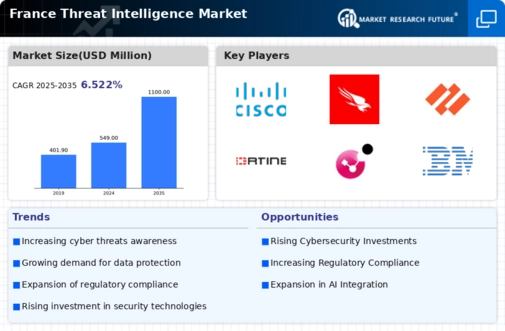Rising Cyber Threats
The escalating frequency and sophistication of cyber threats in France are driving the demand for the threat intelligence market. With cybercrime costs projected to reach €5 billion annually by 2025, organizations are increasingly investing in threat intelligence solutions to mitigate risks. The threat landscape includes ransomware, phishing, and advanced persistent threats, necessitating proactive measures. As businesses recognize the potential financial and reputational damage from cyber incidents, the threat intelligence market is projected to grow significantly. This growth is further fueled by regulatory requirements mandating enhanced cybersecurity measures, compelling organizations to adopt threat intelligence solutions to comply with legal standards. Consequently, the rising cyber threats are a pivotal driver for the threat intelligence market, as companies seek to safeguard their assets and maintain operational integrity.
Regulatory Compliance Pressures
In France, stringent regulatory frameworks are compelling organizations to enhance their cybersecurity posture, thereby propelling the threat intelligence market. The General Data Protection Regulation (GDPR) and the Network and Information Systems (NIS) Directive impose strict requirements on data protection and incident reporting. Non-compliance can result in hefty fines, reaching up to €20 million or 4% of annual global turnover, whichever is higher. As a result, businesses are increasingly turning to threat intelligence solutions to ensure compliance and avoid penalties. The need for real-time threat detection and response capabilities is paramount, as organizations strive to meet regulatory expectations. This compliance-driven demand is likely to sustain growth in the threat intelligence market, as firms invest in technologies that enhance their ability to identify and mitigate potential threats effectively.
Collaboration Among Industry Stakeholders
Collaboration among various stakeholders in the cybersecurity ecosystem is emerging as a vital driver for the threat intelligence market in France. Public-private partnerships, information sharing initiatives, and collaborative frameworks are fostering a more resilient cybersecurity landscape. Organizations are recognizing the value of sharing threat intelligence to enhance collective defense mechanisms. This collaborative approach is particularly evident in sectors such as finance and critical infrastructure, where the stakes are high. The French government is actively promoting initiatives to facilitate collaboration, which is expected to bolster the threat intelligence market. As stakeholders work together to address common threats, the demand for integrated threat intelligence solutions is likely to increase, further propelling market growth.
Increased Awareness of Cybersecurity Risks
The growing awareness of cybersecurity risks among French enterprises is significantly influencing the threat intelligence market. As high-profile data breaches and cyberattacks make headlines, organizations are becoming more cognizant of the vulnerabilities they face. This heightened awareness is prompting businesses to prioritize cybersecurity investments, with the threat intelligence market projected to expand by 15% annually through 2026. Companies are recognizing that traditional security measures may no longer suffice, leading to a shift towards more sophisticated threat intelligence solutions. This trend is particularly evident in sectors such as finance and healthcare, where sensitive data is at stake. Consequently, the increased awareness of cybersecurity risks is a crucial driver for the threat intelligence market, as organizations seek to bolster their defenses against evolving threats.
Technological Advancements in Cybersecurity
Technological advancements are reshaping the threat intelligence market in France, as organizations seek innovative solutions to combat cyber threats. The integration of artificial intelligence (AI) and machine learning (ML) into threat intelligence platforms is enhancing the ability to analyze vast amounts of data and identify potential threats in real-time. This trend is expected to drive market growth, with AI-driven solutions projected to account for 30% of the threat intelligence market by 2027. Additionally, the rise of cloud-based threat intelligence services is providing organizations with scalable and cost-effective options. As businesses increasingly adopt these advanced technologies, the threat intelligence market is likely to experience significant expansion, driven by the demand for more effective and efficient cybersecurity measures.



















Leave a Comment